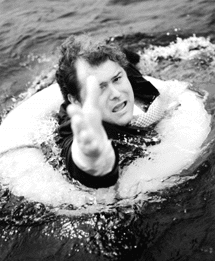Fishing First Aid : Drowning
 This is probably the worst thing that could happen to a fisherman, so best be prepared for it. It's not uncommon to see a small newspaper article saying this or that person drowned in a mining pool.
This is probably the worst thing that could happen to a fisherman, so best be prepared for it. It's not uncommon to see a small newspaper article saying this or that person drowned in a mining pool.Prevention is of course better than cure, use your brain first.
Forget about retrieving that expensive lure, it's not worth your life. Wear that life jacket properly, it will save your life.
OK here are some tips for Near-Drowning first aid. Technically if you had drowned it would be too late already, so it's actually referred to as Near-Drowning.
Near Drowning: First Aid
When someone is drowning, get help immediately, but do not place yourself in danger. Do not get into the water or go out onto ice unless your own safety can be assured. Rescue options may include extending a long pole or branch to the victim, or using a throw rope attached to a buoyant object, such as a life ring or life jacket. Toss it to the floundering person, then pull him or her to shore.
Keep in mind that victims who have fallen through the ice become hypothermic very rapidly and may not be able to grasp objects within their reach or hold on while being pulled to safety.
If a person is still floundering in the water and you are appropriately trained to attempt rescue yourself, do so immediately if conditions do not pose undue risk to your own safety.
Do not be a hero...normally the rescuer drowns as well...
If there is any likelihood of spinal injury, care must be taken to stabilize the victim's head and neck at all times during the rescue and resuscitation.
If the victim's breathing has stopped, begin rescue breaths as soon as you safely can. This often means starting the breathing process while still in the water.
Continue to breathe for the person every few seconds while moving them to shore. Once on land, check for a pulse (or other signs of circulation, such as spontaneous breathing, coughing, or movement) and administer CPR if needed.
For step-by-step instructions on rescue breathing, see CPR and rescue breathing first aid.
The Heimlich maneuver should not be used routinely in the rescue of near-drowning victims. It should be used only if the airway is blocked with debris or vomit, and you are unable to successfully ventilate the victim (unable to get air into the the lungs with proper rescue breaths). Since most drowning victims do not breathe in large quantities of water, immediate rescue breaths are effective without first draining the lungs. Furthermore, performing the Heimlich maneuver unnecessarily may increase the chances that an unconscious victim will vomit, and subsequently choke on the vomitus.
Always use caution when moving a drowning victim. Always assume that the victim may have a neck or spine injury, and avoid turning or bending the neck. Take appropriate steps to immobilize the head and neck during resuscitation and transport. Either tape it to a backboard or stretcher, or secure the neck by placing rolled towels or other objects around it. It is important to keep the victim calm and to keep them immobilized. Seek medical help immediately.
In order to prevent hypothermia, remove any cold, wet clothes from the victim and cover him with something warm, if possible.
Once the victim is stabilized, administer first aid for any other serious injuries.
As the victim revives, he may cough and experience difficulty breathing. Calm and reassure the victim until you get medical help. All near-drowning victims should be seen by a health care provider. Even though victims may revive quickly at the scene, lung complications are common.
Source



0 Comments:
Post a Comment
<< Home